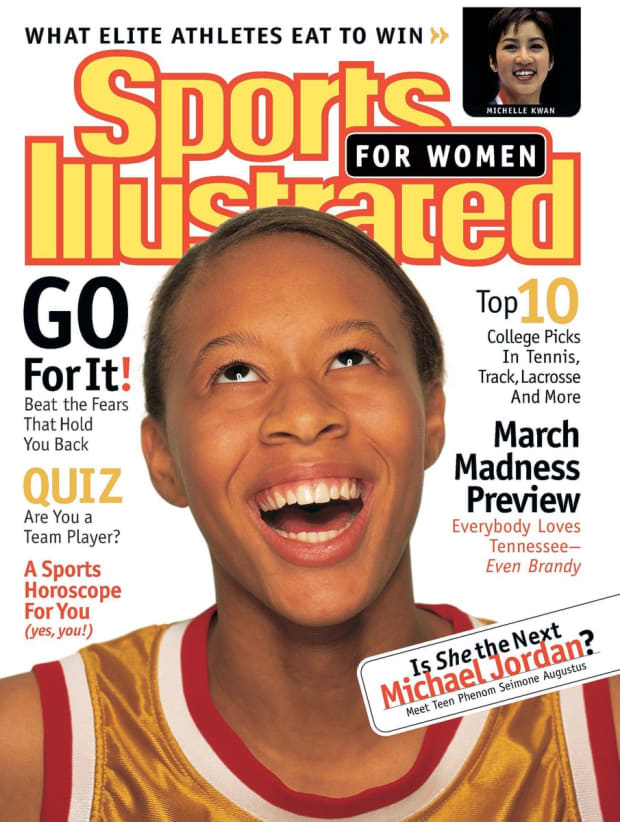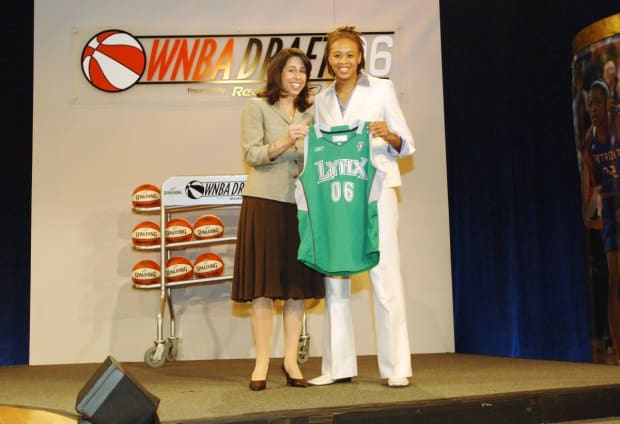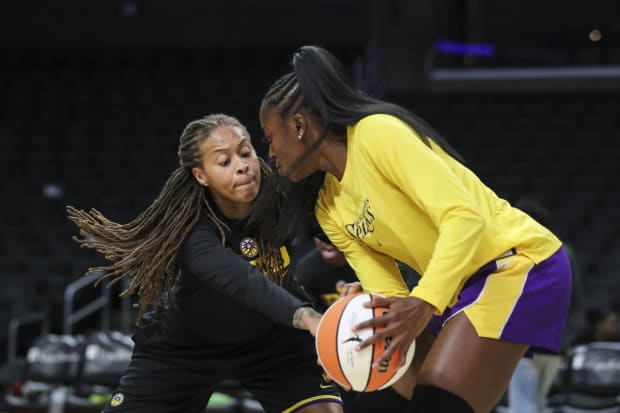Before Angel Reese, Louisiana State had Seimone Augustus. Now a WNBA retiree, erstwhile coach and author, Augustus, 38, led the Tigers to three straight Final Fours in the aughts. Though they never captured the magic of winning it all, Augustus, of course, would get her turn in the pros: As a core part of the Lynx’ dynasty, the guard won league titles in 2011, ’13, ’15 and ’17.
The eight-time All-Star is on par with Shaquille O’Neal for the greatest athlete to come out of LSU—even if Shaq himself doesn’t agree. Augustus sat down with Sports Illustrated to discuss everything from the evolution of WNBA draft fashion to Hoop Muses, her new Shea Serrano–esque illustrated pop culture book with Meadowlark Media personality Kate Fagan. She also dropped a surprising 2023 WNBA championship pick.
This interview has been edited and condensed for clarity.
Sports Illustrated: Congrats on the LSU title. How does it feel?
Seimone Augustus: It feels good! It’s been a long time since, what, ’08, just making it to the Final Four, and never being able to get to the championship game. So to be a part of it, to be in Dallas, to see it and actually experience it, and actually see them after watching them play the entire season, seeing them play their best basketball at the right time, it was amazing.
SI: There was a full-circle moment for you with Angel Reese after that old picture of you two. What did you say to her after the win?
SA: I was just like, “You did it.” I think everybody was at a loss for words. Everybody that came over to me to hug me, embrace me, was almost like, “What just happened?” And I’m just like, “We won!” You’re just trying to process that we just won a national title.
And she came over and she was just like, “This is for you. This is for you.” And in my mind and my heart, I’m just filled with joy. You did it. You all pulled it together and you pulled it off.
I didn’t even know anything about that picture until they brought it up right before the statue [unveiling ceremony]. I don’t even remember that shot. I don’t even remember that moment. But obviously that moment impacted her in a way that for one, got her to this point in her basketball career, but two, it motivated her to do something that even I hadn’t done in my career.
SI: What does it mean to you to have a statue at your alma mater’s arena?
SA: I’m still processing it. You don’t know what it feels like to be a living legend. You normally think these people are—no offense—older or deceased, no longer with us. I’m 38 years old; I’m walking around and I have a statue on campus. And people are able to talk to me and walk around and point to me like, “Yo, that’s the girl. That’s the statue.” I’m no longer Seimone. That’s the statue. [Laughs.] You never get used to it, but I also like to see the glitter and the glow in young girls’ and young boys’ eyes when they’re like, It’s her. I’m more excited about what that’s going to fuel within the next generation of basketball players.

Richard Corman/Sports Illustrated
SI: You once had a Sports Illustrated for Women cover, asking whether you could be the new Michael Jordan. What was that like when you were a kid and then reflecting back on that now?
SA: The pressure! I didn’t even know I was on the cover. A teammate of mine had to go to Walgreens for something and found the magazine on the shelf. She brought it back and was like, “You know you was on the cover of the magazine?” I was like, “No! No!” As soon as that happened, obviously everyone went and bought everything. That whole weekend that’s all that they were talking about. We were actually at the state championship for high school, so it was just a big buzz. From that day forward, it was like I couldn’t go anywhere without … now it’s the statue, back then it was the magazine cover.
You couldn’t go anywhere without people recognizing you. But it also elevated my game. Because everywhere I went, people wanted to beat me. They wanted to prove that they was better than this girl that was on this magazine, or that I wasn’t as good as people said I was. So it actually helped me improve my game both mentally and physically. It also helped me understand there was something even bigger out there. I didn’t think that that was possible until it became possible. From that point on, I just really pushed myself to be the best that I can be. People around me, friends, family, really supported me to see what my elevation to the next level was going to be like. They really wanted to see what I was going to become.
SI: The WNBA draft was Monday night. Do you ever think back to your own draft night, when you went first in 2006, and what about that stands out to you?
SA: These girls get a little bit more time than we did. I just remember we had two or three days to prepare for the draft, so I was running around trying to find an outfit to get ready. Now they have more than enough time, and the outfits were amazing. Zia Cooke, I believe, had one of the best outfits. It was very elegant, very well put together. She looked amazing. [Jordan] Horston from Tennessee, she had a nice swag with hers. They really had time to show off their own fashion sense.
But I also understood the jitters and the fear and the nervousness when they did their interviews of being drafted and what that meant for them and their families and looking forward to the future. “What’s next? I can’t wait for training camp. I just want to help my team.” That’s literally how you feel, so I also felt that embrace, that joy, that happiness of being drafted as well.
SI: In hindsight, how do you feel about your white draft-night suit?
SA: I probably could’ve pizzazzed it up a little bit more. [Laughs.]

David Sherman/NBAE/Getty Images
SI: But that wasn’t the style at the time, right? Everyone was kind of businesslike at the draft.
SA: Yeah, it was straightforward business suits. Everyone at that time, we was going to Ann Taylor. Whatever was in Ann Taylor, stylish. I’ve got my great-aunt, my grandmother. They helped me pick it out, so that shows what they were going for as well.
You admire the fact that these young ladies get a chance to actually show off and have time to put their outfits together and really think about it, think it through, because we didn’t.
SI: Not only do they have more time, it seems like they have more freedom to express themselves.
SA: Yeah, of course, without a doubt. Being able to show your fashion sense obviously makes you more marketable. People need to know what your personality is. Are you a bold person? Do you wear colors? Are you kind of together? I’ve seen a lot of white suits. Aliyah [Boston] had the white suit on, but her hair was very flamboyant and it stood out, and it’s all a part of her style. It actually gives people a chance to see them in a different light as opposed to on the basketball court, which makes it a lot more fun.
SI: The league is predominantly Black. There are so many queer players. What is the significance that so many of them can express themselves authentically with their style?
SA: I’m just happy that the WNBA has become a place where Black women or queer women or queer people can express themselves, because that wasn’t the case always. Within the last five to seven years, maybe, was when we really started to embrace all people and all walks of life. Look at what’s happening. Our fan base is growing. People are now feeling more connected than ever to the WNBA because they can identify with people they see that look just like them or have had similar journeys, trials, tribulations, whatever it is that people connect on, and it just allows people to feel more open, more free.
When you do come into your workspace, you don’t want to feel hindered or like you’ve got to hide yourself, you really want to be yourself in order to be the best team and the best teammate and the best organization. People really have to feel comfortable in the space that they’re working in. So I think the players pushing to make this happen but also the league embracing it has definitely created an environment for people to prosper and grow and become who they are.
SI: Congratulations on Hoop Muses. Why is that the book you wanted to do?
SA: I feel like it’s necessary. We have a moment in time where people need to know more about the women’s game—and not just the WNBA, but the women’s game as a whole. That’s something that’s always disheartening to me, when people go, “What about the game? What about the W? What about this?” And they just don’t know. There’s not enough information out there. So we compiled a book that gave you an actual history, and it started with the future of the WNBA 30 years from now. We hope to be making $100 million and doing all these amazing things. It brings you back to where it started and the fight that we had to do just to be a part of the game and so on and so forth. I think it’s just a piece of history that needed to be acknowledged so that now we can elevate the game. Now young ladies, young men have a source to go to to really understand the fight and the courage that these women had to have to keep this game alive.
SI: It’s interesting that you mention kids, because as far as I can tell, that’s not directly who the book is marketed to. It strikes me as something that kids would definitely love. It’s a history lesson on Pat Summitt in the same space as WNBA Jam stuff.
SA: We wanted to bounce around. That’s why the illustration [by Sophia Chang] is the way it is. If you’re not of age to really process and grab the information, then at least the illustrations will draw you in, and it’s something fun and cool to look at. As you grow and you are of age, I had a lot of parents say, “Look, I’m going to read this to my kids at night at bedtime. Tell them one story about one great woman that was in this book, a great team or a great moment.” I have had a lot of adults who ran through that book in like a day. “It was the most amazing book I ever read!” Just because of the history that some of them were very fond of, they knew, and now it’s being put out there. Now it actually exists in a way people can process it, understand it, learn it.
SI: As a lesbian woman, you were such an outspoken advocate for same-sex marriage. Now I’m wondering what your thoughts are on the attacks on transgender rights our country is facing, including in sports.
SA: People fear what they don’t understand, and they hate what they fear. This is just one of those fears. Even with myself being part of the LGBTQ community, there’s a lot of things I had to learn about trans people even though I’m amongst the community. We have to, for one, think about people who are not amongst our community and not as inclusive and understanding and open, but also figure out ways to continue to push the needle forward.
People should be allowed to be whoever they decide that they want to be and live the life that they decide that they want to live. So that’s why I think the W, even Athletes Unlimited, AU, that was something that I was part of, they were very driven to make sure that trans voices and trans lives were positioned to be showcased, that they supported them and they wanted to figure out ways to help. At the time, we were in Texas, which has some of the most strict, resistant laws against transgender people. So we wanted to make sure we had a voice, and that they also felt like they had a voice within their workplace.

Meg Oliphant/Getty Images
SI: You spent two years as an assistant coach with the Sparks. What did that experience teach you, and what’s it like being on that side of the court?
SA: It’s very different. It’s very different. You never know the amount of work and the amount of effort coaches put in to just game-plan, to get ready for a practice or get ready for a game. To be on that side, not even knowing if I wanted to be on that side for a very long time, to just be able to put my toe in the water and see if I would like it or even love it, was definitely a hope for me. I really did figure out that I do like it, I do love it and I feel like I have a future on that career path, being able to pass on the knowledge that I have and the knowledge that I’m gaining on this journey to help not just grow a team or an organization but our brand, our league and our game.
SI: So what’s next for you on that front?
SA: Right now, taking a break. Because I never do. I didn’t break between playing and coaching. Get a little bit of a break. I don’t know how long, but I am going to jump back into coaching. Not sure if it’s going to be on the collegiate level or pro, but I do see myself being around the game in that capacity.
SI: Since you’re not affiliated with a team right now, maybe you can say: Who is your money on for this WNBA season?
SA: You know what? I mean, everybody has Vegas. But I think Atlanta had a great draft. Atlanta picked up some very good players. In free agency, picking up Allisha Gray. But in the draft, they were able to get No. 15 from South Carolina [Laeticia Amihere], Haley Jones and [Leigha Brown]. They were great additions to a team that’s already stacked and ready to go. They only missed the playoffs by a little bit last year, so I’m expecting them to go into the playoffs and actually make a great run this year.







